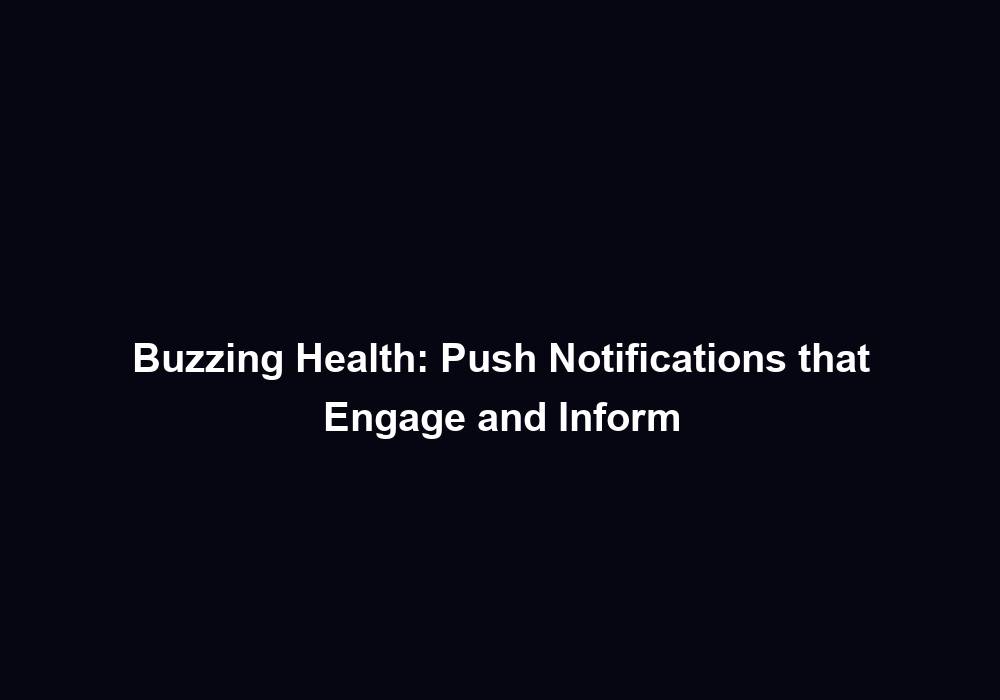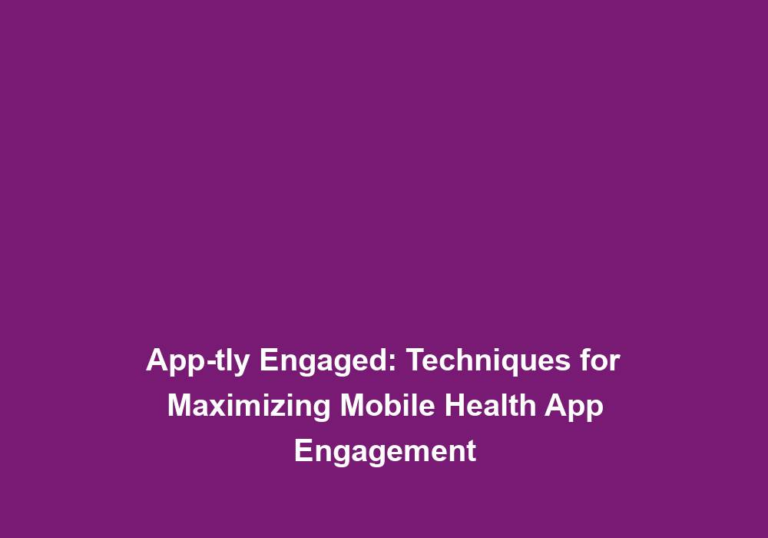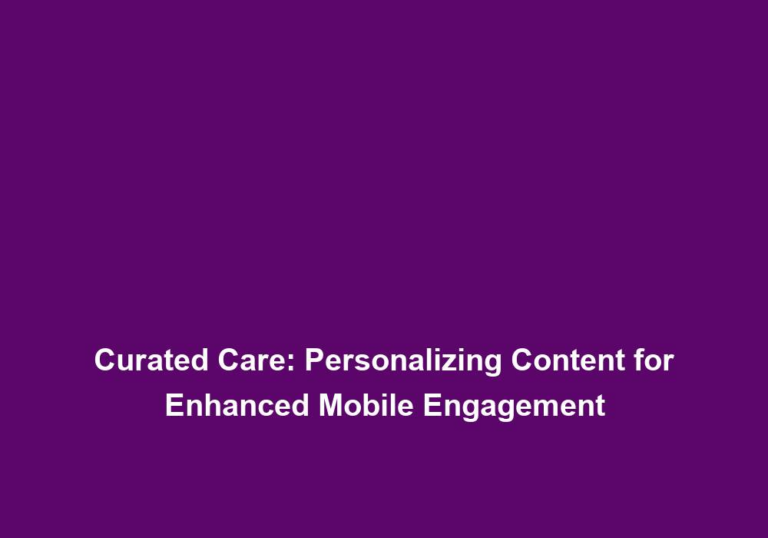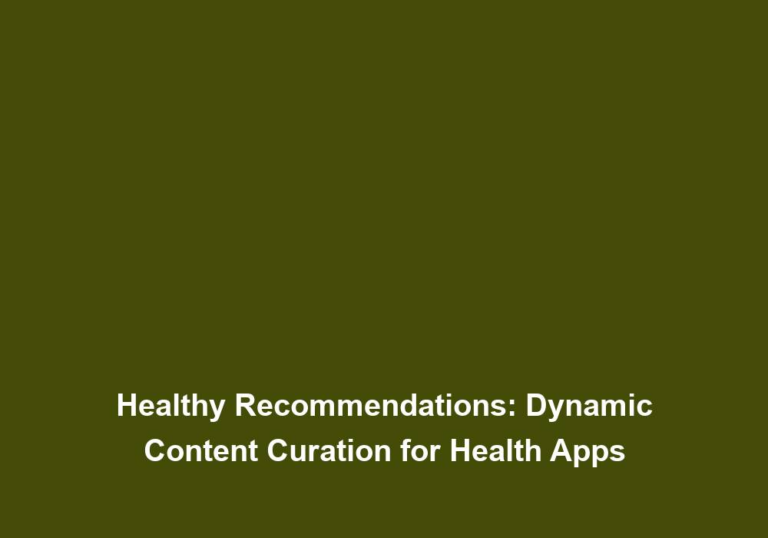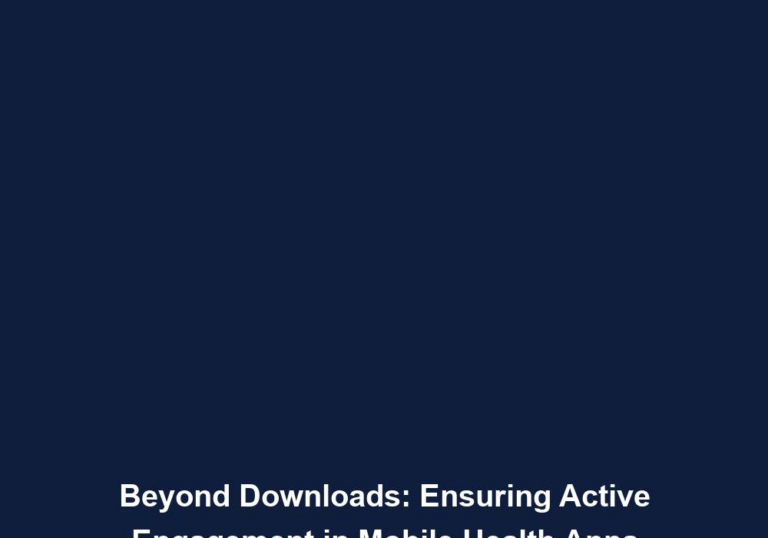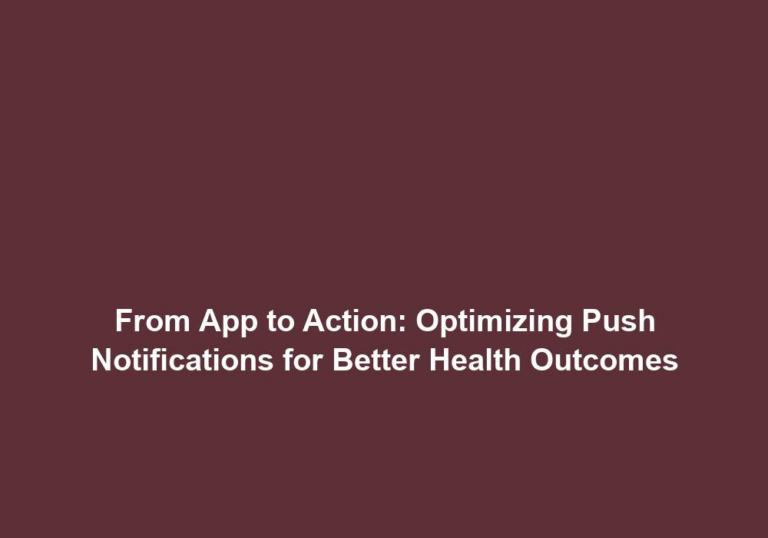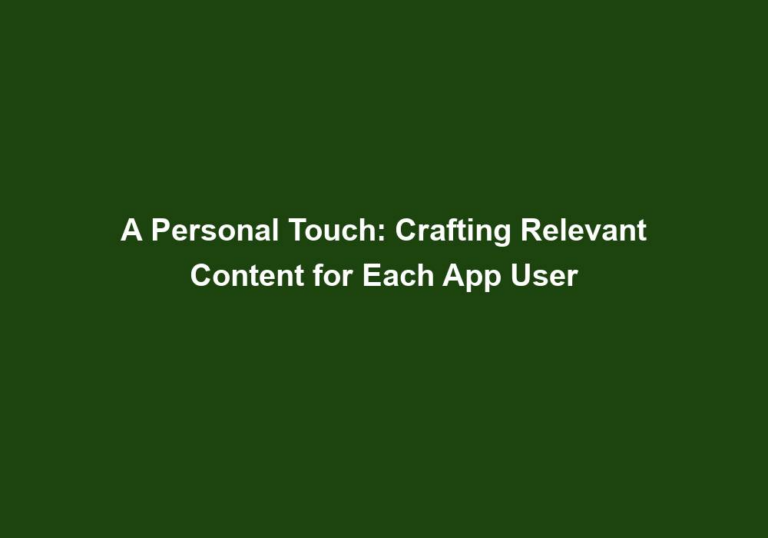Buzzing Health: Push Notifications that Engage and Inform
Push notifications have revolutionized the way we interact with mobile applications. In the world of health and wellness, these notifications play a vital role in engaging and informing users about various aspects of their well-being. This article dives into the power of push notifications in the health industry, exploring how they can effectively engage users and provide valuable information.
The Impact of Push Notifications in Health Apps
Enhanced User Engagement
Push notifications serve as a direct communication channel between health apps and users. They keep users engaged by providing timely and relevant information, reminders, and updates related to their health goals. This active engagement helps users stay motivated, track their progress, and maintain a consistent focus on their well-being.
- Push notifications can remind users to log their daily activities, such as exercise, diet, and sleep, helping them stay accountable and motivated.
- By sending personalized updates on progress and achievements, push notifications can boost user morale and encourage them to continue their healthy habits.
- Notifications can also provide real-time feedback and recommendations based on users’ data, helping them make informed decisions about their health.
Personalized Recommendations
Health apps collect valuable user data, such as activity levels, sleep patterns, and dietary preferences. Leveraging this information, push notifications can deliver personalized recommendations tailored to each individual’s specific needs. Whether it’s suggesting new workout routines, providing healthy recipe ideas, or reminding users to take medication, personalized push notifications ensure the delivery of relevant content, making the user experience more meaningful and effective.
- Based on users’ activity levels and fitness goals, push notifications can suggest customized workout plans and exercises, helping users stay on track.
- By analyzing users’ dietary preferences and health conditions, health apps can send push notifications with personalized meal recommendations, ensuring a nutritious and balanced diet.
- Push notifications can remind users about medication schedules, upcoming doctor appointments, or health-related events, promoting adherence to treatment plans and overall well-being.
Healthy Habit Formation
Building healthy habits is an essential part of any wellness journey. Push notifications can act as gentle nudges, reminding users to adopt and maintain these habits. Whether it’s drinking enough water, taking regular breaks from sedentary activities, or practicing mindfulness, well-timed reminders through push notifications can motivate users to make positive choices and lead healthier lives.
- Push notifications can remind users to stay hydrated throughout the day, providing tips on the importance of water intake and its impact on overall health.
- By sending alerts to take breaks from prolonged sitting or sedentary activities, push notifications can encourage users to engage in physical movement, reducing the risk of sedentary lifestyle-related health issues.
- Push notifications can promote mindfulness and stress reduction techniques, guiding users through breathing exercises or short meditation sessions, fostering mental well-being.
Health Awareness and Education
Push notifications can also play a crucial role in raising health awareness and educating users on various health topics. By delivering articles, infographics, or videos related to specific conditions, prevention techniques, or general wellness, health apps can empower users with knowledge. This not only helps users make informed decisions about their health but also encourages them to take proactive steps towards better well-being.
- Health apps can send push notifications with articles or blog posts on topics such as managing stress, preventing chronic diseases, or maintaining a healthy lifestyle, providing users with valuable information.
- Push notifications can deliver infographics or videos explaining symptoms and prevention measures for specific health conditions, helping users stay informed and proactive about their health.
- By sharing success stories or testimonials from other users, push notifications can inspire and motivate individuals to make positive changes in their lives.
Strategies for Effective Push Notifications
To ensure push notifications in health apps are engaging and informative, it’s important to follow some key strategies:
Keep it Concise
Push notifications should be brief and to the point. Users are more likely to engage with notifications that can be quickly understood. By using clear and concise language, apps can deliver messages effectively without overwhelming users.
- Use short and impactful sentences that convey the main message of the notification.
- Avoid unnecessary jargon or technical terms that may confuse the user.
- Craft notifications that are easy to read and comprehend, ensuring users can quickly grasp the information provided.
Timely and Relevant
Timing is crucial when it comes to push notifications. Sending notifications at appropriate times, such as reminding users to take medication or providing workout suggestions based on their preferred schedule, increases the chances of users engaging with the content. Additionally, notifications must be relevant and personalized to individual preferences, making them more likely to be acted upon.
- Consider users’ time zones and daily routines when scheduling push notifications to ensure they are received at optimal times.
- Personalize notifications based on users’ specific goals, preferences, and past interactions with the app.
- Use real-time data and context to deliver timely notifications, such as reminding users to refill prescriptions or booking follow-up appointments after a specific time period.
Interactive and Engaging Content
Incorporating interactive elements within push notifications can further enhance user engagement. Including buttons or quick actions that allow users to respond directly within the notification itself (e.g., tracking water intake or logging a workout) creates a seamless user experience and encourages immediate action.
- Implement interactive elements like buttons or sliders that enable users to provide feedback or input directly from the notification.
- Allow users to complete simple tasks or actions without having to open the app, such as confirming attendance for health-related events or participating in surveys.
- Use visually appealing images or icons that catch users’ attention and make the notification more engaging.
Segmentation and Targeting
Segmenting users based on specific attributes, such as age, gender, or health goals, enables highly targeted and relevant push notifications. By tailoring content to specific user groups, health apps can deliver personalized recommendations and information, increasing the likelihood of user engagement.
- Analyze user data to identify common characteristics or preferences that can be used to create user segments.
- Craft notifications that address the specific needs and interests of each segment, ensuring the content resonates with the target audience.
- Continuously refine segmentation strategies based on user feedback and behavior to improve the effectiveness of push notifications.
A/B Testing
Testing different variations of push notifications can help determine which message formats, tones, or call-to-actions resonate best with users. A/B testing allows health apps to iterate and optimize their notification strategies, ensuring maximum engagement and effectiveness.
- Create multiple versions of a push notification, each with slight variations in content, tone, or design.
- Randomly assign users to different groups and send each group a different version of the notification.
- Measure and analyze the performance of each variation, including open rates, click-through rates, and user responses, to identify the most effective approach.
Best Practices for Push Notifications
To maximize the impact of push notifications in health apps, it’s essential to follow some best practices:
Respect User Preferences
Users should have control over the frequency and types of notifications they receive. Offering customizable notification settings within the app allows users to tailor their experience based on their preferences. This helps prevent notification fatigue and ensures a positive user experience.
- Provide users with options to adjust notification frequency, including the ability to enable or disable specific types of notifications.
- Allow users to set quiet hours during which they won’t receive any notifications to respect their privacy and uninterrupted rest.
- Regularly seek user feedback on notification preferences and make necessary adjustments to meet their expectations.
Value-driven Content
Push notifications should provide value to users. Whether it’s sharing health tips, progress updates, or offering exclusive discounts on health-related products or services, the content should be meaningful and relevant. Users are more likely to engage with notifications that offer something valuable in return.
- Deliver content that aligns with users’ goals and interests, providing them with actionable insights or information they can apply to improve their health.
- Offer exclusive discounts or promotions on health-related products or services as a reward for user engagement and loyalty.
- Avoid generic or irrelevant content that may be perceived as spam or intrusive.
Clear Call-to-Actions
Including a clear call-to-action within push notifications encourages users to take the desired action. Whether it’s tapping to read an article, tracking a workout session, or scheduling an appointment, a well-defined call-to-action prompts users to further engage with the app and its features.
- Use actionable verbs and concise instructions to clearly communicate the desired action.
- Incorporate buttons or links that lead users directly to the relevant feature or content within the app.
- Ensure the call-to-action is prominently displayed and easily distinguishable within the notification.
Frequency and Timing
Striking the right balance between sending frequent notifications and avoiding overwhelming users is crucial. Understanding user behavior and preferences plays a vital role in determining the optimal frequency and timing of notifications. Consistently bombarding users with notifications may lead to them disabling them altogether, so it’s important to find the sweet spot.
- Analyze user engagement patterns and feedback to identify the optimal frequency of notifications that keeps users engaged without causing annoyance.
- Consider the nature of the notification when determining its timing, ensuring it aligns with users’ daily routines and activities.
- Monitor user response rates and adjust the frequency and timing of notifications accordingly to maintain optimal engagement levels.
Continuous Improvement
Monitoring user engagement and feedback is essential for continuously improving the effectiveness of push notifications. Analyzing key metrics such as open rates, click-through rates, and user responses provides insights into user preferences and helps refine notification strategies over time.
- Regularly review and analyze data on user interactions with push notifications to identify trends and patterns.
- Seek user feedback through surveys or in-app feedback mechanisms to gather insights on notification preferences and areas for improvement.
- Use A/B testing and experimentation to continuously optimize notification strategies based on user preferences and behaviors.
Conclusion
Push notifications have emerged as a powerful engagement tool within the health and wellness industry. By delivering timely, personalized, and informative content, these notifications play a vital role in motivating users, promoting healthy habits, and educating individuals about various aspects of their well-being. By following effective strategies and best practices, health apps can harness the potential of push notifications to engage, inform, and empower users on their wellness journeys.
Note: This article has been written in markdown format.

